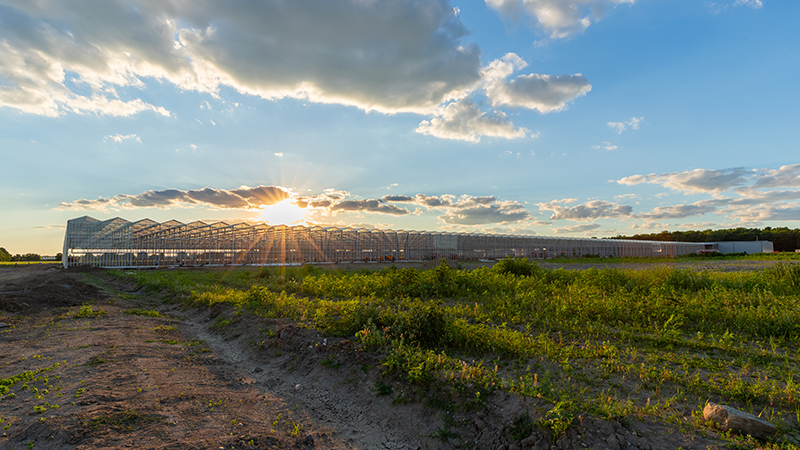A Place For Woody Plants

As the economy improved, in the late ’40s and ’50s, cut flowers vied for space with the tomatoes, and chrysanthemums, carnations and roses became the greenhouse crops of choice. As peace time prosperity settled onto the land, florists popped up, and that market became stronger everywhere. As transportation improved, cut flowers and vegetables moved across the country. However, the vast improvement in global transportation signaled the beginning of the end for both greenhouse vegetables and cut flowers in most states, as overseas transportation costs were reduced.
But the strong economy and increased discretionary income of Americans in the 1960s and 1970s and into the 1980s demanded the good things in life. As more people moved to single-family dwellings, color became an important part of the lifestyle, and the unparalleled growth of the bedding plant began with a vengeance. Spurred by advances in seed technology, automation and plastics, the greenhouse morphed into a sea of color. In the 1970s, the landscapers started to flex their muscles. The landscaper was born of the aristocracy, which had employed dozens of gardeners, but estates soon gave way to suburbia, and someone had to install all this color in American homes and businesses. So was born the landscape profession. The greenhouse industry was flush with the rise of the foundation planting, the colorful geraniums and the tomato seedlings that were part of the American dream.
The latest renaissance of gardening began in the 1980s with magazines, garden clubs, radio and TV personalities to keep the garden news buzzing, the result being that greenhouses were pumping out petunias, geraniums, marigolds and impatiens. However, there were subtle signs of discontent.
Perennial interest soared as people grew a little tired of replacing annuals every year. Writers suggested that perennials were gaining favor because beds and beds of marigolds were, well, boring. This was a good thing for the perennial people, but not so for the greenhouse industry, which was entrenched in the bedding plant model. Another huge omen of things to come was the trend to containers. While this seemed to be a good thing, it foresaw the trend of “less is more.” Downsizing became the mot de jour and the garden bed supporting a dozen geraniums gave way to containers supporting three combination items. However, not to give up, breeders looked away from bedding and, lo and behold, greenhouses were filling with the ubiquitous specialty annual.
Specialty or vegetative annuals were specially designed to capitalize on the trend to downsize. In the last 10 years, bacopas, scaevolas and plants with unpronounceable names like calibrachoa became the petunias of the ’70s. So here we sit, with, as my friend Robert Davis of Davis Floral in Elberton, Ga., says, “all this crazy stuff” in the greenhouse, each with different production needs and schedules. And times are changing again.
Work Or Lifestyle?
Talk to the people who keep their ears to the ground about trends in gardening, and you will hear that gardening is associated with work to avoid; landscaping is a lifestyle to embrace. Plants are out, lifestyle is in. And the “in-trend” that has taken root on the American conscience most is lack of time. For the greenhouse and retail communities, that translates to low maintenance. Today’s suburbanites are looking to relax on their decks, the patio furniture and barbeque being their decoration. They are certainly not looking to deadhead and weed.
Anne Raver of the New York Times wrote about gardeners in a Jan. 3, 2006 article, saying, “Their manic gardening has given way to calmer (although for some more profound) pleasures, like planting a grove of serviceberry trees and watching them change through the seasons.”
So this brings me to the title of this piece. Leaders in the greenhouse industry have always changed, and leaders will try to find their niche in the low-maintenance trend. My bet on the next great group of plants that retailers will demand is “Woody Shrubs.” Edmund Hollander, a New York landscape architect stated in the New York Times article, “If there’s any trend, it’s toward simplicity. Instead of trees in flower from March through September, people want hydrangeas and buddleias.” Those old-time sturdy shrubs, with their striking flowers and leaves, need very little care.
However, we are a conservative group, and like any new trend, it takes time to build a head of steam. It is not that breeders and distributors have not bought into the shrub concept. It is that growers don’t know where to start. Most information on growing shrubs is based on the nursery model, where turnover is measured in years, not weeks. Like perennials, there are literally hundreds of different shrubs, only a few of which lend themselves to the greenhouse model of color, uniformity and rapid turnover. Perhaps this magazine may be a good place to start, as I will outline shrubs we have researched for three years,
In future articles, I will cover pros and cons, schedules for forcing of genera such as abelia, buddleia, caryopteris, hibiscus, hydrangea, kolkwitzia, leycesteria, physocarpus, and many more in 1-gallon containers. I will place these either on my “Winners” list, along with greenhouse schedules, my “Losers” list, those that titillate but don’t offer profitability, and my “Definite Maybe” list, plants that may work with a little tweaking. I will be right-on with some, and miss a bunch, but it will be a start.
I have no doubt that as the downsized, time-challenged public grows in size, low-maintenance plants will become even more popular than they are now. More shrubs will be sold. It is simply a matter of who will produce them. The nursery industry welcomes this trend with open arms. How will the greenhouse industry respond?









